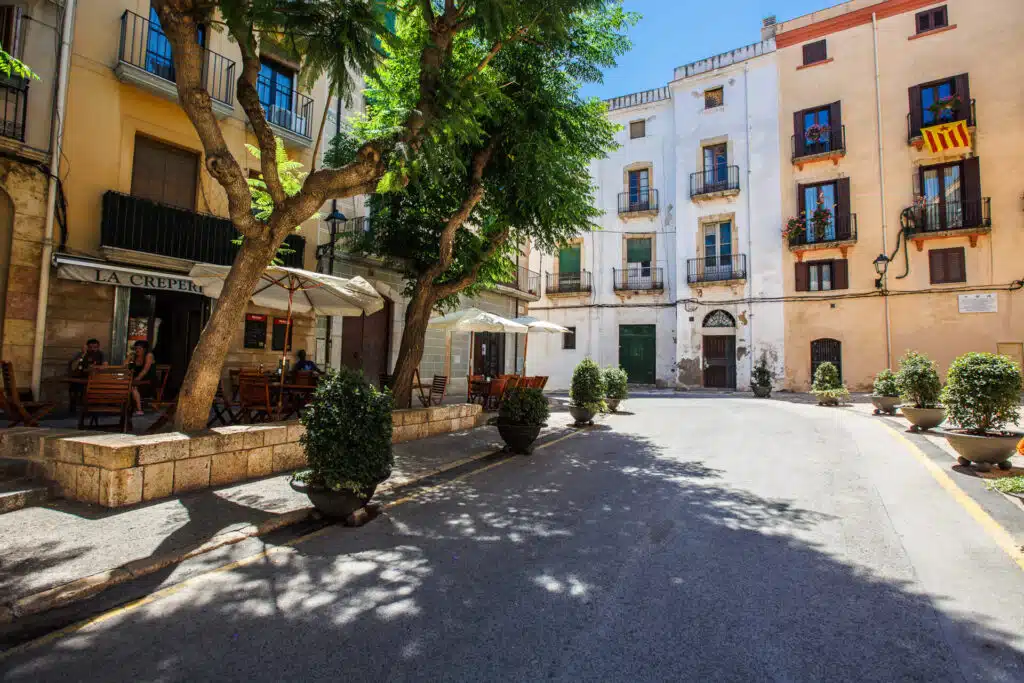If you’re new to Spain, brace yourself for a daily rhythm that is very different from what you may be used to. Here, mornings stretch well into the afternoon, while long midday breaks and late dinners can throw off your inner clock. But instead of resisting, why not go with the flow?
TEFL teacher Lauren sheds light on Spain’s famous siesta tradition with practical tips and insights on how to adapt your routine to Spain’s slow-paced rhythm.
I’m from the UK and I’ve been living in Spain for nearly seven years, first in the south (Andalucía) and now in the north (Asturias). For most of that time, I’ve been a TEFL teacher, teaching a range of ages and levels, but with a focus on Young Learners.
It came as a bit of a surprise when I first arrived to find that most shops and many offices close for a few hours in the middle of the day. (I guess I should have done my research!). But now I’m fully on board with the siesta culture in Spain, and I love the timetable here.
Read: Ways To Work & Live In Spain As A Foreigner
Siesta culture in Spain
If you ask a foreigner what springs to mind when they think of Spain, I’m betting siesta culture is going to be high on the list. The midday break is probably one of the most widely known Spanish traditions.
There are a couple of theories about how the siesta culture emerged in Spain.
Some people believe it originated during the Civil War in the 1930s when, due to difficult economic conditions, many people worked a morning and afternoon job. The two-hour break in the middle of the day gave them a chance to have lunch, rest and travel between workplaces.
Another popular theory is that siestas developed during Spain’s agricultural past, when field workers took long midday breaks to escape the heat before returning to work when it was cooler.
Although the days of two-hour lunch breaks may be over for most, siesta culture still has quite an impact on Spanish society.
For me, siesta is a break taken in the afternoon that may or may not include a short rest or nap.
I don’t know many Spanish people who take a daily nap. Some jobs skip long lunch breaks, but many businesses still close for a few hours midday.
Many Spanish people I’ve spoken to are enthusiastic about the benefits of having a siesta, always insisting that naps are kept short and sweet (usually around 20-30 minutes) to avoid waking up groggy or struggling with insomnia later.
This tradition occurs in both urban and rural areas, although it might be slightly less noticeable in cities, as chain stores tend to stay open. Timings might be more flexible in rural areas.
When I was living in a small town in Andalucía, siestas gradually got longer as the weather got warmer, regardless of the opening times displayed on shop doors.
Siesta culture and working hours
Many businesses are shaped by the siesta culture in Spain. It’s common to see shops and offices close for a few hours midday, especially small or independently-owned places.
This also applies to language academies, banks and some government offices that will have a morning and afternoon timetable.
In some places, you might notice longer gaps between trains and buses during traditional siesta hours. However, this doesn’t apply to chain stores, supermarkets and many offices.
Lots of people work a 9-5 with a shorter lunch break, allowing them to finish earlier than if they had a siesta.
However, some offices have a condensed summer timetable, where staff might start earlier, take even shorter breaks and finish earlier when the weather is cooler. So the Spanish timetable is still very much governed by its hot summers.
Siesta culture and teaching schedules
Most language academies I’ve worked in tend to operate in the afternoons, with the classes for Younger Learners first, followed by teen and adult classes later in the day. These can clash with siesta time — I’ve had parents warn me their child might be sleepy because it’s usually nap time!
Afternoon classes often start between 3:00 and 4:00 pm.
Most language academies I’ve worked in have opened around this time and closed somewhere between 8:00 pm and 9:30 pm (although quite a few only have classes Monday-Thursday, and if they open on Fridays, teachers tend to finish earlier).
I guess they have to operate when people are free to have classes, which generally means after school for the Younger Learners and after work for the adult learners.
Read: What’s The Difference Between Teaching Teenagers Vs Young Learners?
Some language academies hold morning classes or planning sessions, so you may need to go in for a few hours, take a break, and return in the afternoon – usually just a couple of mornings a week.
Hours can vary quite a lot across schools in Spain.
Some primary schools operate from around 9:00 am to 2:00 pm, with the option for students to stay and have lunch in the comedor (school dining hall) afterwards.
Others start at about 9:00 am with a two or three-hour midday break and continue classes until around 5:00 pm.
Secondary schools tend to start a bit earlier (around 8:00 am or 8:30 am) and finish later.
These times might vary during September and June, when many schools might close around 1:00 pm.
This affects the opening hours of private language academies quite a lot and is the reason that most TEFL teachers have the majority of their teaching hours in the afternoon and evening.
It’s also the reason why many language academies don’t open until mid-September or October and might only be open for half of June.
I’ve always looked for academies that stay open the whole of June and September — two months off in the summer is enough for me!
But if you find a language academy that remains open for the full 10 months, you can expect quieter classes in the first few weeks of September and the last few weeks of June.
This is especially true of secondary school students who tend to start the year a little later and finish earlier. Though with the Younger Learners, you tend to still get fairly decent attendance.
(Many parents have mentioned that they are happy for their kids to have a few hours of English classes a week before school starts to keep them busy.)
Adapting your daily routine
Challenges and benefits of siesta culture
Not all of Spain shuts down for siesta, but enough does that it can be frustrating at first, especially if you’re not used to it.
However, it also means that many businesses will still be open later in the evening to cater to people who work a 9-5 role. And it’s nice to see town centres are still lively after 6:00 pm.
Adapting to a Spanish timetable might be challenging initially, especially if you’re a morning person, as everything tends to be a little later: shop opening times, meal times, etc. But generally, I would say the work-life balance here is much better than in other places I’ve lived.
If you’re lucky enough to have mornings free, it’s a great time to fit in appointments you’d normally need time off for in a 9–5 job.
I love it that I can go to the shops and supermarket when it is quieter.
The biggest challenge for me at first in terms of energy was the post-lunch slump — unfortunately, it hits right when most language academies open!
I’d eat lunch as late as possible before class, have a light afternoon snack, and a late dinner at home — but I still got sleepy sometimes. A room full of boisterous five-year-olds will soon cure you of that!
I would say that a long midday gap makes it easier to maintain energy, especially in a TEFL-teaching environment, which can be quite intense at times.
Advice for adapting your daily routine to siesta culture
Try and fit the rhythm of daily life in Spain. If you try to keep a different schedule, you’re going to end up frustrated.
Finishing late means eating dinner later and going to bed later. So if you’re an early riser but finishing late, you’ll possibly feel overtired quickly, unless you nap after lunch.
I’ve always been more productive during the evenings, so I love the timetable here. I also have many friends who work shifts and love that we can use mornings or Fridays to hang out or visit places when it’s quiet.
Sometimes, working split shifts can tire you out or make you feel like all you’ve done is work all day, so it’s important to switch off during your breaks.
However, I’d take a couple of split shifts with Fridays off over a standard 9-5 any day of the week.
Siesta culture and private ESL lessons
The busiest times of day for private English lessons tend to be in the afternoon and early evening.
Some employers provide English lessons for their staff, which can be taken during working hours, so they may opt for morning classes.
As a freelancer, you can decide whether or not you want to work through siesta, if you have students interested in those hours. If you don’t, you can always look for students outside of Spain.
If you teach online, there will always be someone somewhere whose time zone makes it the perfect time for them to have classes.
Read: 11 Best Places To Teach English Online With No Degree [2025]
Siesta culture and time zones
The beauty of online teaching is that if you state your teaching hours, someone somewhere in the world will always be looking for a class within that timeframe.
You can choose hours that suit you and look for students in countries where peak demand for lessons coincides with your availability.
I think it’s just a case of organisation, doing your homework, and being aware that the clocks will change twice a year in some time zones.
So if you have back-to-back classes, you might need to reorganise things a bit in March and October.
Common mistakes adjusting to siesta culture
A common mistake TEFL teachers (and newcomers to Spain) make is assuming the day is divided the same way as back home.
💡Tip: If a student asks about your availability, ask them for a range of hours.
I feel like this is also linked to siesta culture with mornings extending until lunch time, which is, of course, later here. It turns out that in Spain, morning can be anytime until about 3:00 pm.
It really threw me when I first arrived when someone asked me to meet for a morning coffee. I suggested 10:00 am as a meetup time, and they suggested 1:00 pm!
I’ve also seen gyms that offer ‘morning deals’ where you pay a lower rate, but can only use the gym in the ‘morning,’ meaning until 3:00 pm.
The same applies to the afternoon and after-lunch plans — the afternoon tends to extend later, after siesta. So if you suggest 2:00 pm or 3:00 pm for an afternoon plan, you might get some funny looks.
And good luck booking a restaurant for an evening meal before 8:00 pm, as many won’t open till then, and that will still be considered quite early for dinner for most! I guess it makes sense when people eat lunch later.
On the plus side, as a TEFL teacher, even if you don’t finish until 9:00 pm, you can still make it to dinner with friends after!
But the biggest mistake is probably assuming that things will be open all day, every day.
If you need to go to the shops or do any admin tasks that require a visit to the bank or a government office, it’s always best to check the opening times first.

Also, make sure you’ve done any shopping you need to do before Sunday. This doesn’t necessarily fall under the category of siesta culture, but most shops will be closed, including supermarkets.
There are a few exceptions, like bakeries and some pharmacies. This can be a pain if you run out of something or forget to buy something.
But in general, I think it’s a sign that Spain has got its priorities right, with Sundays set aside for relaxing or spending time with friends and family.
Making it work daily
Tips for managing siesta culture for ESL teachers
✅ Take proper breaks during the day.
I think the biggest thing to avoid when trying to adapt to siesta-influenced schedules is not taking proper breaks.
If you’re used to a morning school timetable or working 9-5, it’s a mistake to think that you can maintain your old morning routine and take the same short breaks despite your workday ending a lot later.
If you’re working in a language academy, make sure you take advantage of breaks between classes. It’s far too easy to think ‘I’ll just plan this lesson’ or ‘I’ll just prep this activity’ and, before you know it, your break is over.
✅ Organise your time well.
It can be quite difficult when you first start teaching and are receiving too much information at once, like timetables, class details, student info, while visiting countless offices to sort out your paperwork, find accommodation (and your way around your new home). But once you’re settled in…
… it’s important not to let working through breaks or over your allotted hours become a habit.
✅ Keep your teaching timetable updated.
If you’re working as a private tutor, make sure you schedule breaks and keep your timetable updated, so that you don’t accidentally end up with six or seven back-to-back classes.
It’s all about finding a routine that works for you.
✅ Prep meals in advance.
I find that meal prep can really help, especially if you finish late and don’t feel like cooking when you get home, or are just exhausted after the school day.
✅ Stay hydrated and keep snacks on hand.
Drinking lots of water throughout the day makes a difference.
✅ Keep snacks on hand.
Keeping a few healthy snacks in your classroom helps.
✅ Find time to exercise.
Finding a way to fit in exercise, even on days you work split shifts.
✅ Prioritise sleep.
Make sure you get enough sleep. Teaching requires a lot of energy, and you don’t want to be so tired that you can’t take advantage of living in and exploring a new country and meeting people on the weekend.
✅ Embrace the culture.
But above all else, embrace it. Siesta culture is an important part of living in Spain, with many benefits. After all, who doesn’t enjoy a lovely lunch that doesn’t finish until 5:00 pm?

Author Bio
Lauren is a Web Content Writer & Editor for The TEFL Academy with a background in media, film, and education, and a passion for language and learning. A University of Cape Town graduate, she holds a PGCE, is a licensed teacher, and is TEFL-qualified. She has taught English to learners of all ages and levels, both in South African and South Korean classrooms, as well as online. When she’s not writing, she’s likely deep into academic readings or enjoying a well-earned gym session.
Read
Lauren Johnstone's story →
 United States
US
United States
US




















